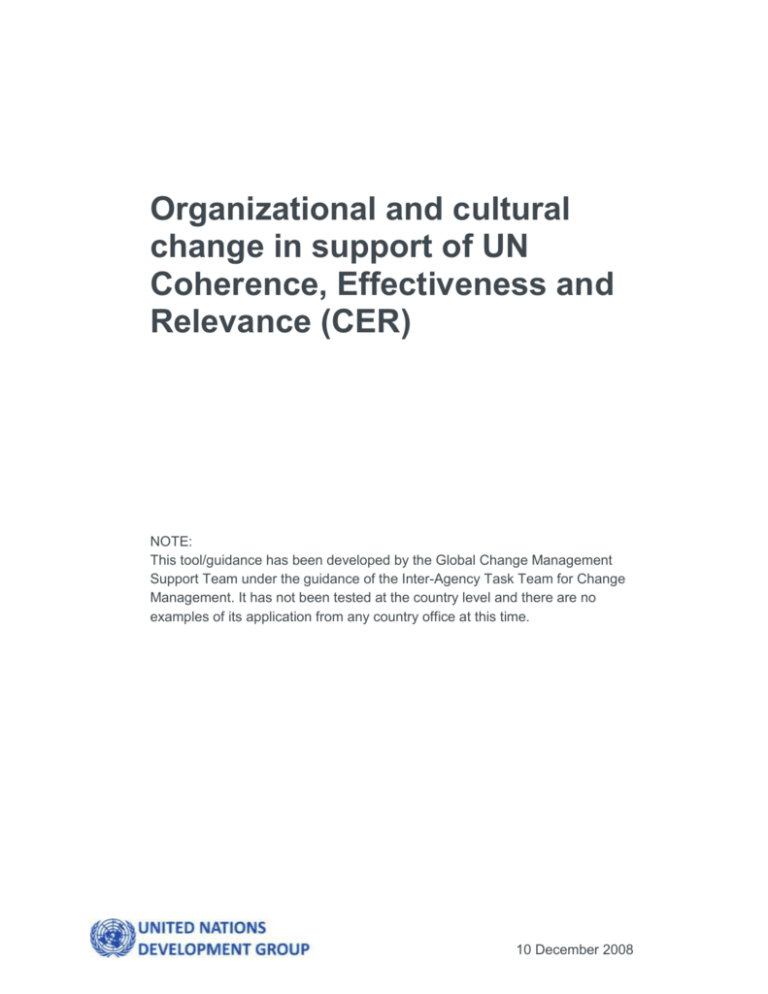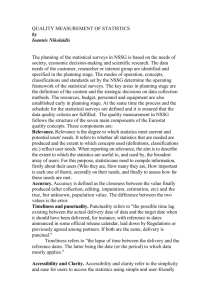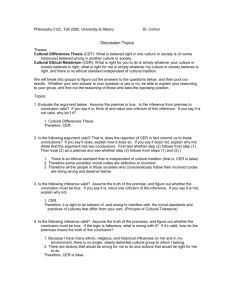Guidance Note organizational and cultural change
advertisement

Organizational and cultural change in support of UN Coherence, Effectiveness and Relevance (CER) NOTE: This tool/guidance has been developed by the Global Change Management Support Team under the guidance of the Inter-Agency Task Team for Change Management. It has not been tested at the country level and there are no examples of its application from any country office at this time. 10 December 2008 Table of Contents 1 2 3 4 Introduction and background ..................................................................................4 Definition: What is organizational culture? .............................................................5 Key challenges and steps for changing organizational culture ...............................6 Tools for changing organizational culture ...............................................................8 iii 1 Introduction and background Step 3 provided guidance on strategic results frameworks (what are the results we want to achieve) and operational mechanisms (how are we going to achieve those results), and therefore sets the basis to define the UNCT strategy for the coming cycle, both for the programme and business operations. Step 4 provides guidance on the identification of the organizational change that will facilitate and support the actual realization of these results. Inevitably, achieving the results and implementing the operational mechanisms identified under Step 3 in a coherent manner involves the development of more integrated planning and governance mechanisms (ref step 3: Guidance note on development of integrated business and operations strategy), which would imply a change in the way people work and engage within the UN system. Beyond the organizational and technical issues, a change in UN culture and behaviour is key: each agency’s culture and behaviour need to be changed so that they support Coherence, Effectiveness and Relevance. UN System level culture and behaviour – that build on but go beyond individual agencies’ cultures – need to be developed and strengthened. This guidance on cultural and behavioural change identifies what organizational culture is, how it influences staff behaviour and how these cultural and behavioural aspects can be adjusted to support UN Coherence, Effectiveness and Relevance and optimize performance and delivery of the UN System as a whole. 1 1 For a broader overview of the Coherence, Effectiveness and Relevance methodology, please refer to the toolkit website 2 Definition: What is organizational culture? Organizational culture is a concept in the field of organizational studies and management which describes the attitudes, experiences, beliefs and values of an organization. It has been defined as "the specific collection of values and norms that are shared by people and groups in an organization and that control the way they interact with each other and with stakeholders outside the organization. Organizational values are also known as "beliefs and ideas about what kinds of goals members of an organization should pursue and ideas about the appropriate kinds or standards of behavior organizational members should use to achieve these goals.” 2 In order to understand the organisation culture, and determine the best way to influence it, it is important to analyse and comprehend what composes it. To this end, several elements can be used to describe organisational culture.3 The Paradigm: What the organization is about; what it does; its mission; its values. Control Systems: The processes in place to monitor what is going on. Role cultures would have vast rulebooks. There would be more reliance on individualism in a power culture. Organizational Structures: Reporting lines, hierarchies, and the way that work flows through the business. Power Structures: Who makes the decisions, how widely spread is power, and on what is power based? Symbols: These include organizational logos and designs, but also extend to symbols of power such as parking spaces and executive washrooms. Rituals and Routines: Management meetings, board reports and so on may become more habitual than necessary. Stories and Myths: Build up about people and events, and convey a message about what is valued within the organization. Lastly, culture is a word used to describe the behaviours that represent the general operating norms in an organisational environment. Though culture is not usually defined as good or bad, it inevitably influences the behaviours of the individuals within the organisation. When thinking about UN Coherence, Effectiveness and Relevance, it ought to be kept in mind that each agency will have its own organizational culture, and that the key challenge is to build on the specificities of each culture to create and strengthen one that promotes a collaborative and coordinated way of working together. 2 Charles W. L. Hill, and Gareth R. Jones, (2001) Strategic Management. Houghton Mifflin. 3 Johnson, G. (1988) "Rethinking Incrementalism", Strategic Management Journal Vol 9 pp75-91 3 Key challenges and steps for changing organizational culture When trying to change an organizational culture, some key challenges usually arise: Organizational culture is learnt, and grows over time as a result of interaction among staff members and other stakeholders of an organization. While people know exactly what the current culture entails, they might not be fully familiar with a new vision, or new working modalities. While they know exactly which pros and cons are associated with the current situation, they might not necessarily understand how their personal situations will evolve in a new arrangement. Most people tend to be comfortable with the current organizational culture as it frequently echoes the prevailing management style. Since managers tend to hire people just like themselves, the established organizational culture may be reinforced by new appointments. When thinking more specifically about UN Coherence, Effectiveness and Relevance, there are some additional issues that need to be taken into account when trying to change the prevailing culture: Efforts at much greater coherence, effectiveness and relevance are at an early stage. It is the first attempt of this kind that the UN system has undertaken. This might generate uncertainty in staff. Staff might not be fully aware of the specific benefits that strengthened Coherence, Effectiveness and Relevance could bring about. Although they all belong to the same system, UN agencies have very specific cultures and staff members are used to being “loyal” to their agency’s culture much more than to an overarching UN –System culture. Considering that UN CER entails moving beyond each agency’s perspective and embracing a broader point of view (although in circumstances when this might be in contrast with an agency’s specific interest), it is not surprising that change might encounter resistance. Changing an organizational culture is therefore not an event but rather a (long) process, which entails: 4 Understanding of the current culture –Surprisingly there are many cases in which staff and managers within an organization are not fully aware of all the elements in the culture of an organization. A detailed observation of the current culture, which might include a more structured approach such as organizational culture surveys, is key to ensure that the following questions can be answered and future steps to foster change undertaken4: o What are the current core values or belief systems of staff? o Will the current value system impede the change and how? o Which current values might motivate group/collective action? o What is the impact of the current culture of the organization on the organization itself and the community that it serves? Assessing what the culture should look like – in which direction does the organization culture of different agencies need to go to ensure that organizations act in a coherent, effective and relevant way? What are the values that need to be represented in the organizational culture for change to happen? Are they in line with the current organizational cultures? Motivating individuals to modify their behaviours in order to create the desired organizational culture. Motivating individuals to modify their behaviours is very challenging. Several steps, as well as mechanisms and tools in support of them are required, as described in the following chapter. http://www.healthyculture.com/Articles/CCplanner.html 4 5 Tools for changing organizational culture5 Develop a motivating vision for UN CER and set clear vision, value and belief statements: A clear and concise motivating vision is needed to inspire a large number of staff members to change. People need to know what UN Coherence means, what its implications are, why change is desirable and why they should make the effort to support it. A motivating vision is one that enables people to imagine new possibilities for the country and its development, for the United Nations within the country and as a whole, and for themselves as United Nations staff members. Establish a sense of urgency: Establishing a sense of urgency is crucial in ensuring that complacency is overcome. In many cases, UN CER is not an option. It’s a specific request from the country Governments and from donors. Outcomes of surveys conducted with relevant external stakeholders and other information that create a solid argument for change should be made available for staff members to clearly understand why change is needed and necessary. Successful examples of improvements in UN CER achieved in other countries should be shared so that staff members can visualize the effects of change. Ensure Management support: One of the necessary prerequisites when attempting changes in organisational culture is leading from the top. It is essential that management (RC and UNCT) supports the cultural change, beyond just verbal support. The leaders must lead the change by changing their own behaviours and model the desired behaviour themselves. This in turn will create trust amongst the UN staff members and inspire them to follow the leadership. Utilize effective two-way communication and transparency: Keeping all staff members informed about the goals and aspects of the organizational culture change process minimises anxiety and ensures their commitment. One example of doing this is ‘townhall’ meetings of all UN staff. Additionally, ongoing communication ensures that every staff member is clear on what is expected from her or him, while providing a positive outlook on the future changes (i.e. opportunities for growth, learning, career development) which are brought about by UN Coherence, Effectiveness and Relevance. Lastly, communication should incorporate feedback mechanisms and respond to the needs of the staff members, thus furthering their trust in the leadership. http://humanresources.about.com/od/organizationalculture/a/culture_change_2.htm Review systems for rewards and recognition: Performance management involves individual goal setting, performance appraisal, and reward systems that align staff member culture and behaviour with organizational strategy and goals. Addressing human resources issues related to performance management, and developing a performance management system that fully supports UN CER is therefore key to ensuring a successful change management process. Many human-resource issues in general and performance-management issues more specifically have been observed in several country contexts and have been raised and discussed in different fora. Longer-term and sustained interventions to address these issues will require a thorough processes and systems review and will require broad and coordinated action at the headquarters level. There are, however, some quick wins that UNCTs can adopt at the country level, within the existing processes and systems. These can help leverage the performance management system in support of UN System CER (see Guidance note on Performance Management). Invest in staff development and training: It has already been outlined that most organizational cultures are learnt and are a result of long term interactions between staff members of an organisation. Staff members need to be coached to “unlearn” undesirable behaviours, and embrace new ones. Furthermore, staff members need to be empowered to operate within the UN CER environment and that a new set of “rules”, values and beliefs, consistent with CER is developed.








